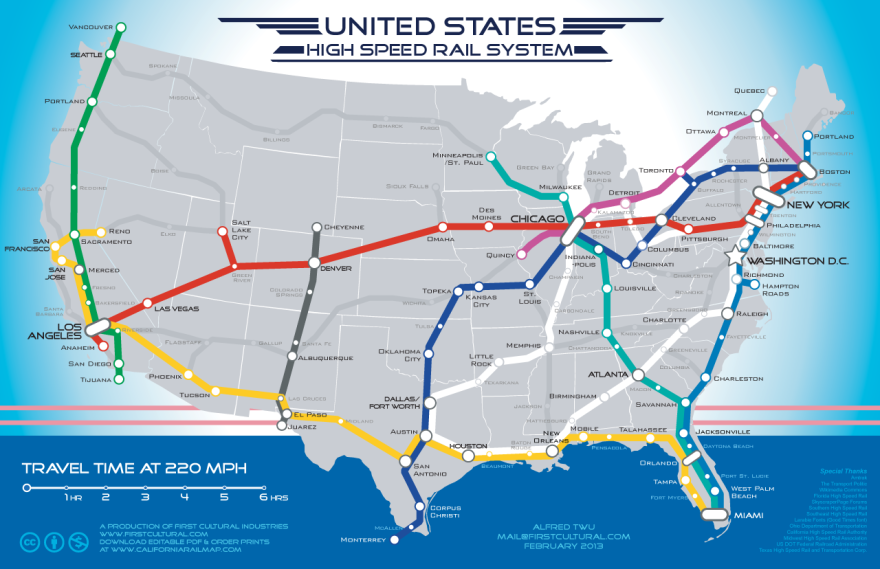Austin Mayor Lee Leffingwell has promised a public vote on an urban rail system before he leaves office. Considering Austin was just ranked the fourth worst U.S. city for traffic congestion, that news could make for a lot of happy commuters.
Meanwhile, a California group envisions a national high-speed rail system that could transport a person from any major city to another in hours. And this vision has Austin as major train connection hub.
California Rail Map has unveiled its vision for a national high-speed rail system. Its map features color-coded rail routes with speeds of 220 miles per hour. The map connects almost every major U.S. city and even goes international, with stops in Quebec, Tijuana, Juarez and Vancouver.
The maps’ creator, Alfred Twu, had this to say about his project:
The map is based on the work of several government agencies and advocacy groups. … In 2009, the Obama administration released its map of designated high speed rail corridors for federal funding, and there were also many organizations and bloggers that created maps and analysis of where high speed rail should go. At the time, I thought, while these maps were all very well thought out and were great for policy papers, with their gaps and focus on regions and phasing, from a marketing perspective, they lacked elegance and excitement.
The map puts Austin smack-dab in the center of all the southern lines. In Twu's concept, it's only six hours to Los Angeles, seven to Chicago, and an hour to Dallas, San Antonio and Houston.
Of course, things are moving a little more slowly here.
Austin has MetroRail, which runs from Leander to Downtown. While benefiting from an increased weekday ridership, the Austin American-Statesman reports weekend ridership is down, currently averaging about 50 passengers per train.
And last spring, Austin’s Transportation Department unveiled its recommended urban rail routes. City planners predict 9,000 to 11,0000 urban rail passengers between the Mueller development and downtown each day. But some wonder if the rail shouldn’t be more centrally located, like in the Lamar/Guadalupe corridor.
The Transportation Department delivered a briefing on the region’s transportation plans – urban rail included – to the City Council last week. The department was joined with representatives from Capital Metro and the Lone Star Rail District, which are partnering on regional transportation issues under the banner of Project Connect. (You can view the rail presentation to council online.)
The presentation called for creating a Central Texas rail system by 2025. Its backbone would be the seven cities served by Lone Star (Georgetown, Round Rock, Austin, Buda, Kyle, San Marcos, and San Antonio). Austin stops would then feature rail extensions to further destinations, like Austin-Bergstrom Airport, South Congress and North Lamar – although some local transit advocates argue corridors like Guadalupe and Lamar should be served first instead of the Mueller area.
Given the funding, logistical and political issues, rail in Austin is still a ways away – not to mention California Rail Map’s fast and colorful vision of a rail-linked Lower 48. But President Obama has continued to push for high speed rail funding, and outgoing Department of Transportation Secretary Ray La Hood has recently said that 80 percent of the country will be connected by high speed rail in the next 25 years, “because this is what the American people want.”
So will Austin be the urban, high-speed, traffic-free city of the future? The verdict: to be determined.
Until then, you can always order a poster of the map for your wall, to go along with your Austin subway map.
Correction: This article originally stated an estimate of 7,000 Austin urban rail passengers daily. A more recent estimate from the city is 9,000 to 11,000 passengers. This post has since been updated to reflect this correction.






